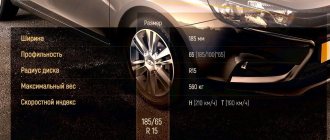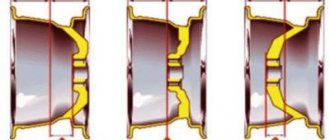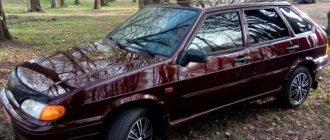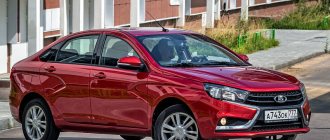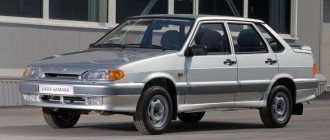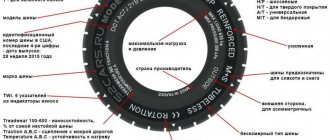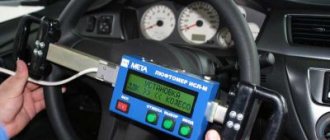The J segment, according to the European classification, includes cars of the SUV class - sport utility vehicle, that is, for sports and utilitarian purposes. This term is used for station wagon cars, predominantly equipped with an all-wheel drive system and distinguished by increased ground clearance.
BMW X3
The segment includes two categories of cars that differ in design - SUVs and crossovers. The difference between these two categories is the all-wheel drive design and the capabilities it has. If a crossover is a station wagon with increased cross-country ability, then an SUV is a full-fledged “all-terrain vehicle” with a comfortable interior and a number of design attributes necessary for city and highway driving (ABS, EBD, and so on).
Signs of a Class J car
In recent years, the SUV segment has been developing at a rapid pace, so apart from a station wagon body and high ground clearance, a J segment car has no permanent features. If previously the body and components of an SUV were installed on a frame, which served as another distinguishing feature of this class, now even a car with very good cross-country ability, falling under the category of SUVs by all criteria, can have a monocoque body. This design helps reduce weight and save fuel.
Renault Duster
By the way, it was the appearance in the early eighties of the first SUVs with a monocoque body that contributed to the development of a new type of car, which is now commonly called a crossover.
An SUV differs from a minivan, first of all, in that the latter’s body structure, as a rule, has a clearly visible engine compartment that protrudes forward. At the same time, the interior layout can be exactly the same as that of a minivan—J-segment SUVs with a flat floor (without a transmission tunnel) and three rows of seats are often found.
Tips for choosing a class
When choosing a car class, focus primarily on your budget, as well as personal preferences. You can usually find out what class a car belongs to on the official website of the brand. You can select several classes, make a table and write down several models, dividing the table into items about dimensions, engine power, and interior capacity.
The car class is more of a reference for quick comparison of models and better orientation in market segments. The lowest price is for class A+ cars, and the most expensive are luxury class cars. Accordingly, as the class increases, the cost of the car increases, and its technical characteristics also become better.
- Auto The Japanese are cooler than the Americans: the most reliable cars of 2022 have been named Consumer Reports has published a traditional rating of automobile brands.
- Author: Alexander Ponomarev
History of the development of the J segment
The predecessors of SUVs were small utility buses with a supporting frame (for example, the 1935 Chevrolet Carryall-Suburban - the ancestor of the modern Chevrolet Tahoe and Cadillac Escalade) and military vehicles (such as the legendary Willys MB, a US Army vehicle during World War II). Early representatives of long-wheelbase SUVs in the modern sense were the Soviet all-wheel drive GAZ-61 of 1938, the Willys Jeep Wagon of 1948, and the Land Rover Series II 109 of 1958.
The last 25 years for the J segment have been marked by increasing comfort and moving closer to road cars in terms of speed, agility and safety.
The term SUV appeared in the 80s. The concept of Sport Utility arose because at the beginning of the boom, SUVs were often used to transport sports equipment - skis, bicycles, etc. The prototype of modern crossovers was the Jeep Cherokee (XJ), an SUV with a monocoque body. Interestingly, even at that time the Cherokee advertising campaign was based on the advantages of an SUV over a traditional station wagon. This trend continues to this day: sales of crossovers are based on the advantages of all-wheel drive and increased ground clearance while maintaining body capacity.
Jeep Cherokee (XJ)
The last 25 years of development of the J segment have been marked by increasing the comfort of all-wheel drive vehicles and gradually bringing them closer to road cars in terms of speed, agility and safety. In this regard, the SUV's ground clearance gradually decreased, and in the Opel Mokka, for example, it is as low as in the average station wagon.
Opel Mokka
European classification of vehicles by ABCDEF classes (Table)
At the moment, in countries around the world there are various car classification systems, all of them use the following parameters as the basis: body dimensions (dimensions) and engine power and volume, passenger compartment volume, market segment, average cost. The tables below show the various classifications of cars and how they compare and contrast with each other.
European car classification A, B, C, D, E, F, J, by target market segments
European car classification is based more on target market segments than on the technical parameters and characteristics of cars; there are no clear boundaries between segments; not only those are used. parameters but also market value, various sets of options. The classification includes 9 main classes: A, B, C, D, E, F, J, M, S.
| Classes | Name | Description | Examples |
| A class | Mini cars | European especially small class or microcars. Very small, up to 3.6 meters, mostly ladies' cars. Economical, very low gas consumption. | Oka, Matiz, Spark, Chery QQ... |
| B class | Small cars | European small class, compact class. Its dimensions are up to 4.2 meters in length, inexpensive and economical, the most popular and affordable. | Lada Vesta, Granta, Solaris, Logan, Nexia, Aveo, Yaris... |
| C class | Medium cars | European lower middle class; "golf class" They grow up to 4.5 meters long. Spacious interior and large trunk. | Golf, i30, ceed, Cruze, Corolla, Civic, Lada Priora... |
| D class | Larger cars | European middle class; family class. Vehicles up to 4.6 meters long. Suitable for family people with a large comfortable interior, a large trunk, this also includes expensive cars with many options. | Accord, Volga, Audi A4, Mondeo, Passat, Sonata, Camry, bmw 3 … |
| E class | Executive cars | European upper middle class; "Business Class". Vehicles no longer than 5 meters. Cars for wealthy people. emphasizing their social status. | Audi A6, BMW 5, Lexus ES, Genesis, Jaguar XF, Mercedes-Benz E-class... |
| F class | Luxury cars | European upper class; executive class. Vehicles with a body length of more than 5 meters. The most powerful engines, expensive interior (leather, rare wood), maximum options. emphasize the highest social owner status. | Mercedes-Benz E-class, Rolls-Royce Phantom, Maybach 62, bmw7, lexus LS… |
| J class | Sport utility | SUV, "off-road vehicles". Vehicles with increased cross-country ability, are spacious, have all-wheel drive, and generally have a frame structure. | Santa Fe, Kuga, X-Trail, RAV-4, bmv x1, x3, x5, Land Cruser Prado... |
| M class | Multi purpose cars | Minivans, compact vans, microvans. For a large family, very roomy, seats up to 9 pieces. | C-max, Carens, Verso, Zafira, Carnival, Hyundai H-1 |
| S class | Sport coupe | Sports coupes, sports cars and supercars. Powerful engine, very high speed, optic body. Mostly expensive cars, some very expensive ones! | 911, Zonda, Lamborghini, Ferrari 488, FF, Nissan GT-R... |
Table of classification of cars by class, their features and sizes
| Car class | Class name options | Body type | Length (mm) | Width (mm) | Wheelbase (mm) | Engine capacity |
| A | microcars | Hatchback 3-5 | 3200 – 3600 | 1495 – 1640 | 2200 – 2446 | 0,8–1,4 |
| IN | compact class | Hatchback 3-5. Wagon Sedan | 3610 – 3990 | 1640 – 1680 | 2370 – 2490 | 1,1–2,0 |
| WITH | small medium, golf class | Hatchback 3-5 Wagon Sedan | 4000 – 4300 | 1700 – 1777 | 2510 – 2640 | 1,2–1,8 |
| C-High* | small medium, golf class | Hatchback 5 Wagon Sedan | 4375 – 4550 | 1700 – 1773 | 2510 – 2641 | 1,4–2,0 |
| D | family class | Sedan. Liftback Wagon | 4520 – 4730 | 1746 – 1812 | 2670 – 2754 | 1,6–3,2 |
| E | Business Class | Sedan Wagon Liftback | 4740 – 4900 | 1775 – 1335 | 2700 – 2840 | 2,0–3,5 |
| F | executive class | Sedan | 5000 – 5169 | 1830 – 1903 | 2830 – 2991 | 3,0–5,0 |
| S | sports coupe | — | — | — | — | — |
| M (MPV-0) | minivan | — | 3500 – 4040 | 1720 – 1500 | 2360 – 2630 | 1,0–1,8 |
| M (MPV-C) | minivan | — | 4000 – 4550 | 1700 – 1370 | 2736 – 2760 | 1,4–2,0 |
| M (MPV Large) | minivan | — | 4500 – 4780 | 1720 – 1965 | 2800 – 3000 | 1,3–2,9 |
| J (SUV Mini | off-road crossover | — | 3845 – 3590 | 1555 – 1630 | 2250 – 2420 | 0,7–1,5 |
| J (SUV Compact) | off-road crossover | — | 4195 – 4500 | 1765 – 1820 | 2468 – 2625 | 1,6–2,5 |
| J (SUV Medium) | off-road crossover | — | 4400 – 4560 | 1755 – 1890 | 2360 – 2750 | 2,4–4,0 |
| J (SUV Large) | off-road crossover | — | 4610 – 5090 | 1760 – 2065 | 2400 – 3120 | 3,2–5,5 |
| J (SUV Pick-Up) | off-road crossover | Pick-Up Double Cab Single Cab | 3345 – 5090 | 1555 – 2065 | 2250 – 3120 | 1,5–6,5 |
| J (SUV Premium Compact) | off-road crossover | — | 4550 | 1850 | 2790 | 2,0–3,0 |
| J (SUV Premium Medium) | off-road crossover | — | 4565 | 1853 | 2795 | 2,5–3,0 |
| J (SUV Premium Large) | off-road crossover | — | 4633 – 4793 | 1840 – 1923 | 2715 – 2855 | 2,5–5,4 |
| C-Premium | — | Hatchback 3-5 Sedan | 3630 – 4440 | 1670 – 1770 | 2400 – 2730 | 1,6–2,5 |
| D-Premium | — | Sedan Wagon | 4550 – 4700 | 1730 – 1300 | 2600 – 2730 | 1,6–2,4 |
| E-Premium | executive class, business class | Sedan Wagon | 4720 – 4380 | 1800 – 1330 | 2700 – 2860 | 1,3–3,5 |
| Luxury Premium | — | Sedan | 5730 – 6170 | 1918 – 1990 | 2745 – 3825 | 5,0–6,7 |
| H (Roadster) | — | — | 3420 – 4320 | 1610 – 1720 | 1150 – 2440 | 0,7–2,2 |
| H (Roadster Premium) | — | — | 4010 – 4320 | 1710 – 1780 | 2400 – 2540 | 1,8-3,2 |
| S (Coupe Low) | — | — | 4270 – 4490 | 1700 – 1760 | 2530 – 2680 | 1,6-2,7 |
| S (Coupe Premium Low) | — | — | 4040 – 4720 | 1730 – 1820 | 2420 – 2720 | 1,8–5,4 |
| S (Coupe Premium High) | — | — | 4430 – 4760 | 1770 – 2045 | 2350 – 2690 | 3,6–6,2 |
Classification of cars in the USSR by size
Cars in the USSR were classified depending on engine displacement and dry weight, each class was divided into the first and second groups. In modern Russia, this system is partially used, for example, to calculate the tax base, and partially for internal use in factories.
Comparison table comparing different car classifications
The table contains a comparison of various car classification systems - USA, UK, Russia, European main (segments) and examples of cars of these systems.
| USA classes | Great Britain | Russia classes | Europe (Market Segment) | Examples of cars |
| Microcar | Microcar, Bubble car | Motorized stroller | A class | Isetta, Smart Fortwo |
| Subcompact car | City car | City car | Chevrolet Spark, Volkswagen up!, Ford Ka, Peugeot107, Opel Agila, Kia Picanto, Fiat500, Suzuki Alto | |
| Supermini | Small class | B class | Volkswagen Polo, Ford Fiesta, Peugeot208, Opel Corsa, Citroën DS3, Kia Rio | |
| Compact car | Small family car | Golf class, Small medium | C class | Volkswagen Golf, Ford Focus, Peugeot308, Opel Astra, Hyundai Elantra, HondaCivic, BMW 1 |
| Mid-size car | Large family car | Middle class | D class | Volkswagen Passat, Ford Mondeo, Peugeot508, Opel Insignia, Hyundai Sonata, Honda Inspire |
| Entry-level luxury car | Compact executive car | Audi A4, BMW3, Mercedes-Benz C-class, Volga31105 | ||
| Full-size car | Executive car | Full size car | E class | Ford Crown Victoria, Chevrolet Impala, Honda Accord, Holden Commodore |
| Mid-size luxury car | Business Class | Audi A6, BMW5, Mercedes-Benz E-class | ||
| Full-size luxury car | Luxury car | Executive class | F class | Audi A8, BMW7, Mercedes-Benz S-Class |
| Sports car | Sports car | Sports car | S class | Chevrolet Corvette, Porsche911 |
| Grand tourer | Grand tourer | Gran Turismo | JaguarXK, Maserati GranTurismo | |
| Supercar | Supercar | Supercar | Bugatti Veyron, Pagani Zonda | |
| Convertible | Convertible | Cabriolet | Mercedes-Benz CLK-class, VolvoC70, Volkswagen Eos | |
| Roadster | Roadster | Roadster | Audi TT, BMW Z4, Porsche Boxster | |
| — | Leisure activity vehicle | — | M class | Peugeot Partner, Škoda Roomster |
| — | Mini MPV | Microvan | Ford B-Max, Opel Meriva, HondaFit | |
| Compact minivan | Compact MPV, Midi MPV | Compact van | Ford C-Max, Opel Zafira, Volkswagen Touran, Renault Scenic | |
| Minivan | Large MPV | Minivan | Ford Galaxy, SEAT Alhambra, Chrysler Town & Country, Mazda5 | |
| Mini SUV | Mini 4x4 | — | J class | Daihatsu Terios, Mitsubishi Pajero iO, Suzuki Jimny |
| Compact SUV | Compact 4x4 | Compact crossover | Jeep Liberty, HondaCR-V, Kia Sportage, Toyota RAV4 | |
| — | Coupe SUV | Off-road coupe | Isuzu VehiCROSS, BMW X6 | |
| Mid-size SUV | Large 4x4 | Medium SUV | BMW X5, Jeep GrandCherokee, Volkswagen Touareg | |
| Full-size SUV | Heavy SUV | Cadillac Escalade, Chevrolet Suburban, Range Rover, SsangYong Rexton, Toyota Land Cruiser | ||
| Mini pickup | Pickup | Pickup | — | Chevrolet Montana, FiatStrada, Volkswagen Saveiro |
| Mid-size pickup | Chevrolet Colorado, Ford Ranger, Mitsubishi Triton/L200, Nissan Navara | |||
| Full size pickup | Dodge Ram, Ford F150, GMC Sierra, Nissan Titan, Toyota Tundra | |||
| Giant pickup truck | Chevrolet Silverado, Ford Super Duty, Ram Heavy Duty |
Basic information on the classification of cars by class is taken from the site ru.wikipedia.org
J segment cars in the USSR and Russia
In 1957, the Moscow Automobile Plant produced the Moskvich-410/411/431 experimental car, an all-wheel drive modification of the Moskvich-402 production model. The car was built on a monocoque body, unlike GAZ models of an earlier period and SUVs produced around the world since the mid-twenties. Since Moskvich appeared long before the launch of the Cherokee XJ, perhaps it should be considered the world's first crossover.
SUVs in the USSR were also produced by the Ulyanovsk Automobile Plant (model 469 and others) and VAZ (Niva 2121 crossover). Nowadays, the production of updated versions of these SUVs continues.
Attempts to produce domestic SUVs were also made at other factories: for example, the Derways company produced the all-wheel drive Derways Cowboy (Derways 3131) of its own design in the city of Cherkessk. True, the car did not achieve much success in the market.
